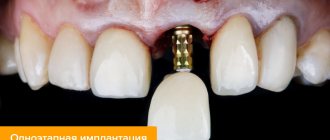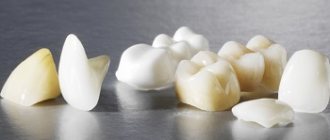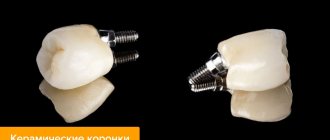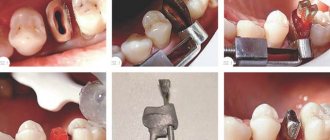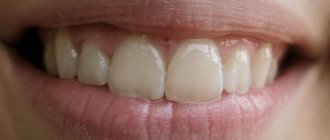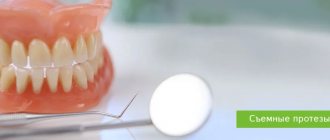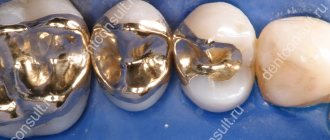Indications for the installation of porcelain crowns
The main indication for the installation of porcelain crowns is the aesthetic restoration of the front teeth:
· wedge-shaped defects and chips that cannot be eliminated using filling material;
Complete destruction of the dental crown;
· enamel hypoplasia;
Abnormalities in tooth color or shape;
· a pronounced change in the shade of tooth enamel that cannot be corrected using professional hygiene methods.
In addition, such designs are suitable for patients who are allergic to metal.
Contraindications
Relative
the procedure can be carried out with extreme caution
- Complex combined malocclusions;
- increased abrasion of the enamel of the antagonist tooth;
- inflammatory processes in the mouth;
- increased sensitivity of teeth;
- pregnancy;
- allergy to anesthetics;
- acute infections;
- period after radiation therapy, stroke, heart attack;
- mental disorders;
- exacerbation of a chronic disease.
Absolute
the procedure is strictly prohibited
- Teeth with living pulp in children and adolescents;
- severe periodontitis;
- oncological processes in the oral cavity;
- allergy to prosthesis material;
- decompensated diabetes mellitus.
Stages of manufacturing and installation of porcelain crowns
First of all, at the appointment, the dentist examines the patient’s oral cavity, identifies possible contraindications, and, if necessary, carries out a complete sanitation. Only after this can you proceed to the next stage - preparing the tooth for a porcelain crown and selecting the optimal shade for the future design using a special template.
Next, the doctor takes a combined impression of the tooth and the entire dentition. And if the quality of the casts is satisfactory, it is sent to a dental laboratory, where a plaster model is made based on them.
Direct production of a porcelain crown can be carried out in two ways. The first involves layer-by-layer application of porcelain substance, and the second uses injection molding technology. It is the second option that is more modern and gives the structure high strength,
Therefore, it is used in most dental laboratories.
After the impression falls into the hands of a specialist, he uses thin platinum foil to create a mold for the future dental crown and fills it with a porcelain composition, and then exposes it to high temperatures several times.
The final stage of making a porcelain crown is the correction of the structure, its staining and glazing.
After the crown is ready, it is first tried on. If the result suits both the doctor and the patient, it is finally fixed on the previously prepared tooth.
Plastic crowns
Installing plastic dental crowns is the most economical and efficient method of prosthetics. Their production occurs very quickly, so the patient can receive ready-to-use products in just one visit to a specialist. However, false teeth made of plastic are much more fragile and short-lived compared to their counterparts made of metal-ceramics or metal. In this regard, in most cases, such products are used as a temporary solution while more reliable crowns are made from other materials.
Benefits of porcelain crowns
· High aesthetics. Porcelain has almost ideal optical characteristics. It very accurately conveys the natural shade and translucency that are characteristic of natural tooth enamel.
· Hypoallergenic design and inert material. Porcelain does not have thermal conductivity, so tooth sensitivity to temperature changes is reduced. Since the crown does not contain a single gram of metal, it can be installed in patients who are allergic to it.
· Long service life. With proper care, the structure will last a very long time, approximately 10-15 years, without losing its performance characteristics.
· Resistant to staining and darkening. Porcelain crowns do not lose their shade and shine, maintaining their original appearance for a long time.
· Minimum adaptation time. The patient quickly gets used to the lightweight and comfortable design.
· Easy to care for. Crowns do not require special care. It is enough to use a high-quality toothbrush and toothpaste, and treat them with care.
Care tips and cost
With careful and proper care, ceramic dentures can last 10-15 years. And zirconium ones – up to 20 years. The main recommendations are simple:
- Maintain oral hygiene.
- Regularly, 2 times a day, thoroughly brush your teeth.
- Rinse your mouth with antiseptic solutions after each meal (or just water).
- Use dental floss and irrigator to clean the interdental space.
It is recommended to choose a soft or medium-hard toothbrush so as not to scratch the surface of the ceramic. Do not use bleaching products at home. The shade of artificial enamel will not change, but the structure of the prosthesis can be damaged. It is better to visit the dentist once every six months for a routine examination and professional teeth cleaning. Do not abuse hard foods: crack nuts with your teeth, open bottles, etc.
The cost of crowns is influenced by the type of material, manufacturing and installation methods, as well as the qualifications of the doctor. On average, the price per unit is 9 thousand rubles and above.
Disadvantages of porcelain crowns
· High cost of construction. It is due to the complexity of technical work, which requires very high professionalism from a specialist.
· Relative fragility of the material. Patients have to avoid eating solid foods.
· Restrictions on indications. Porcelain crowns are not placed on all teeth.
· Manufacturing of single crowns only. Porcelain is not suitable for creating and installing bridges.
pros
The high price of installing ceramic dentures ceases to be an obstacle when you understand the advantages of the design.
The main argument is 100% compatibility with the body. Ceramics does not cause allergies, galvanism, does not change the color of the gums and does not worsen the condition of the oral cavity.
Despite the fact that frameless dentures are slightly inferior in strength to metal dentures, they can fully withstand the chewing load.
In addition, ceramics are resistant to external influences: pigmentation, cracks and chips, temperature changes, and even the appearance of plaque on the surface of the prosthesis. The lack of thermal conductivity relieves the patient of unpleasant sensations, even if a healthy (living) tooth is placed under the crown. By the way, ceramic crowns can be placed on a living tooth, without removing the pulp. This preserves the process of tissue regeneration in the natural tooth and protects it from premature destruction.
Another advantage of the orthopedic design is the possibility of installation on an implant. The crowns are compatible with titanium pins and do not cause discomfort or side effects.
And, of course, ceramic dentures are synonymous with impeccable aesthetics and are completely identical to natural teeth.
Varieties of porcelain designs
Dental porcelain is an excellent material that provides ample opportunities for aesthetic restoration. Several types of structures are made from it:
· Veneers. These are thin plates designed to hide minor defects in tooth enamel. They cover only the front surface of the tooth. Porcelain, composite or zirconium dioxide can be used in their manufacturing process.
· Tabs. These are microprostheses made in a dental laboratory. They help solve more serious dental problems with teeth and are used, for example, in cases of severe decay of the crown or the presence of a large carious cavity.
· Crowns. The most versatile design that allows you to achieve a “Hollywood” smile. They are installed on the front teeth during aesthetic restoration.
Metal dental crowns
Here it must be said that metal dental crowns can be made using two completely different methods.
A) Stamped dental crowns
They are made from standard materials (stainless steel, in rarer cases gold). In our country they are still used, unfortunately, and are also very fashionable to this day in the countries of Asia closest to us.
If you do not plan to settle in an African-American ghetto or in the Asian countries of the former USSR, then such a smile is unlikely to evoke admiring glances from others...
Throughout the civilized world, our person can easily be identified using such “fixes”. In fact, the place of this technology has long been in the museums of medical universities and students should study it not in the cycle of orthopedic dentistry (as is still the case), but exclusively within the framework of such a useful subject as the “history of medicine”. I will therefore not dwell on these dental crowns in detail. The technology is the simplest (a technician cuts a metal cylinder blank to the required length and, tapping it with a hammer, brings the shape closer to the semblance of a tooth), the cost is a pittance. For the same amount of money you get the same kind of treatment.
Minuses:
- complete absence of any aesthetics (although some residents of the above-mentioned countries could argue with me in this place);
— the edge of the crown hangs between the tooth and the gum, being an excellent tool for accumulating food reserves for a rainy day, causing chronic inflammation of the gums, circular caries, giving the breath a corresponding aroma;
— inability to create a normal anatomical shape; most often, such crowns have an absolutely flat chewing surface, worsening the chewing process and causing problems in the temporomandibular joints;
- the thin walls of such crowns often wear out and rub through, leading to the destruction of the tooth underneath by caries...
I think this is quite enough.
This photo shows stamped dental crowns coated with “gold” titanium nitride. Spraying itself is a carcinogen and is prohibited for use in civilized countries. Here you can clearly see the condition of the crowns themselves and the surrounding tissues after several years of wear. Oddly enough, a crown that has not fallen out for many years does not mean quality treatment. Here you can see what is happening around the crown...
... and here's what's happening underneath. The teeth are completely rotten and cannot be replaced with prosthetics.
An example of a single stamped dental crown without coating...
... and a whole bridge. Such flat chewing surfaces without a pronounced anatomical relief lead to numerous problems that are not always easy to treat. This is especially true for diseases of the temporomandibular joint.
Pros:
— it would be unfair not to mention at least some advantages. If you show the miracles of tolerance, then I can hardly squeeze out two - low cost, minimal processing of tooth tissue. That's it, let's forget about them.
B) Cast metal dental crowns
This is a more modern option, which is widely used in modern dentistry and has a right to life. The technology for making a cast dental crown involves the entire standard sequence (this is discussed in the first part of how dental crowns are installed): processing a tooth with a ledge, taking an impression, casting a model, modeling the crown from wax and melting the wax blank into metal. If all stages are properly completed by the dentist and technician, the result is a crown that fits exactly to the tooth and well reproduces its anatomical shape. It can be made from a conventional alloy (most often KHS - cobalt-chromium alloy) or from a precious alloy, which is certainly better.
Cast metal crowns function at the proper level, are durable and reliable. Therefore, if you are not embarrassed by the prospect of sending sunbeams into the eyes of your interlocutor with your teeth when smiling in clear weather, then you can completely opt for them...
Minuses:
- extremely low aesthetics, although the lateral teeth, which are not so noticeable when smiling and communicating (especially the upper ones), can well be restored with just such crowns
— allergic reactions to metal (especially ordinary alloy) are possible
Pros:
- high wear resistance
- relatively low price
Metal ceramics or porcelain: what to choose?
This question arises among patients quite often. After all, each design has its own advantages and disadvantages. Thus, metal ceramics are distinguished by their high strength and affordable price, and porcelain has excellent aesthetic characteristics. Typically, the choice between them depends on which tooth needs to be restored. Crowns made of metal-ceramics are most often installed on chewing teeth, and porcelain crowns are installed on incisors and canines. However, if a porcelain crown has a zirconia framework, it can be used to restore any tooth.
